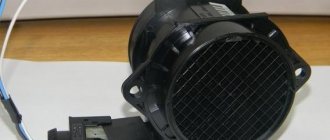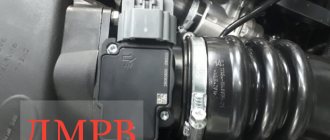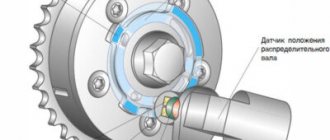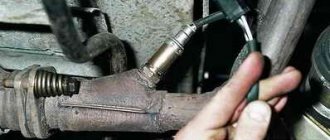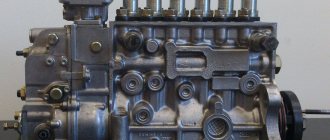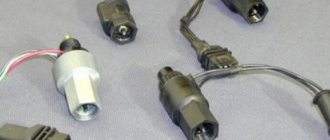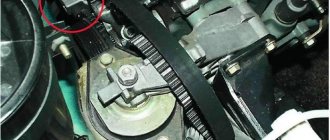The main signs of a malfunction of the mass air flow sensor (another name is a flow meter, mass air flow sensor, MAF-sensor) - increased fuel consumption, interruptions in engine operation (loss of power, floating speed, stalls at idle, hard to start when cold) and other similar symptoms of a malfunction Therefore, this sensor is also checked in parallel.
To find out exactly what the reason is, a comprehensive diagnosis of the car is carried out using a scanner (tester) or a random check of sensors, including a flow meter, a multimeter (voltmeter) and other methods. We will discuss these and other points further.
What is he responsible for?
The MAF sensor plays an important role in forming the correct air-fuel mixture. The sensor constantly monitors the volume of air passing through the intake system and transmits the received data to the ECU.
The latter, having received information from the flow meter and other sensors, forms a fuel-air mixture that guarantees engine operation at optimal speeds with minimal fuel consumption.
Other sensors can also correct the MAF readings: atmospheric pressure and air temperature, but they are not installed on all cars.
If the MAF sensor is broken, then the volume of incoming air is determined by the controller based on the angle of the throttle valve. This does not ensure economical operation of the engine, but the car drives.
Checking and repairing at home
There are eight ways to independently check amplitude and frequency mass flow sensors.
Method No. 1 - disabling the air flow meter
The method consists of disconnecting the sensor from the fuel system of the car and checking the functionality of the system without it. To do this, you need to disconnect the device from the connector and start the engine. Without a mass air flow sensor, the controller receives a signal to switch to emergency operation mode. It prepares the air-fuel mixture only based on the throttle position. If the car moves faster and does not stall, it means that the device is faulty and requires repair or replacement.
Method No. 2 - flashing the electronic control unit
If the standard firmware has been changed, then it is unknown what reaction of the controller is programmed in it in case of an emergency. In this case, you should try to insert a 1mm thick plate under the throttle stop. The turnover should increase. Now you need to pull out the chip from the air flow meter. If the power unit continues to work, then the cause of the malfunction is the firmware.
Method No. 3 - installing a working sensor
Install a known good part and start the engine. If after replacement it begins to work better, the motor does not stall, then replacement or repair of the device is required.
Method No. 4 - visual inspection
To do this, use a Phillips screwdriver to unscrew the clamp holding the air collector corrugation. Then you need to disconnect the corrugation and inspect the internal surfaces of the air collector corrugation and the sensor.
Types and principle of operation of flow meters
The mass air flow sensor is a hot-wire device.
The main types that are used on cars:
- Film with analog and digital signal.
- Wire (thread) analog.
- Frequency mass air flow sensor. Already installed on most modern cars coming off the assembly line.
Pitot tube (vane type) flowmeters are not considered due to their outdated design.
The operating principle of the first two types of devices is similar to each other and is based on changing the voltage readings supplied to the heating elements (threads or film). The ECU monitors these changes and performs calculations to form the fuel-air mixture. More details below.
Wire mass air flow sensor
Used on most modern cars. In such devices, the key role is played by thermistors - two tungsten or platinum filaments with a diameter of 0.07 mm, to which voltage is applied with a certain current strength, as a result they heat up, as well as a thermistor (temperature sensor), but it is not provided everywhere.
One thread is closed from the air flow, and the second, with the throttle valve open, on the contrary, is blown and actively cooled.
To equalize the temperature readings of thermistors, more current is supplied to the open thread.
The ECU takes into account the difference in voltage readings between the threads, the intensity of their cooling and, based on them, calculates the volume of incoming air and, in accordance with this, calculates the required amount of fuel supplied to the cylinders.
Wire mass air flow sensors have several significant disadvantages: over time they become dirty or wear out.
To solve the first problem, the designers developed a self-cleaning mode. It provides for short-term (so as not to discharge the battery) heating of the filament to 1000-11000C with the engine turned off. At this temperature, all deposits burn out.
When the thermistors wear out, the sensor is replaced.
Film flowmeters
Structurally, such sensors differ from the first ones, although the principle of their operation is largely the same.
Instead of a sensitive thread thermistor, a platinum-coated ceramic heating element or semiconductor film is installed here.
The location of the film device remains the same, and the ceramic element itself has several resistor layers, each of which performs its own function: a temperature sensor, a heating one, two thermistors.
An important advantage of such a sensor is that it measures the temperature of not only the incoming air, but also the reflecting air. The device is also less susceptible to contamination.
It is worth noting that in modern devices, the output signal U is transmitted not only in analog mode, but also in digital mode, this speeds up data processing.
Frequency mass air flow sensor
The General Motors product was installed on the first VAZ 2109 and worked in tandem with the January 4 ECU. It is characterized by reliability and a long service life.
The principle of operation is not based on a change in direct voltage, but on a change in the frequency of the output signal of an alternating signal U. When the frequency is high, this indicates high air flow, low frequency indicates low air flow.
The main advantage of a frequency flow meter is stable data transmission to the ECU when the voltage in the circuit drops (poor contact, oxidation, etc.).
Let's imagine that the contacts in the connectors have oxidized. Then the output signal of 1.02V will decrease and, for example, 0.9V will come to the controller. This is not critical, but it will increase fuel consumption.
In the frequency sensor, voltage surges do not affect the operation of the ECU in any way. Oxidation of the contacts will not change the signal frequency in any way, which means 100% of the output data will reach the recipient, i.e. controller (ECU).
Mass air flow sensor MAF MAF
The Mass Air Flow (MAF) sensor is the most important sensor for the proper operation of the fuel injection system. This sensor determines the amount of air that has entered the engine, and based on this information, the control unit calculates the amount of fuel that needs to be supplied to the cylinders.
As a rule, the mass air flow sensor does not “die” completely, i.e. The Check Engine (CE) light does not come on. For the self-diagnosis system built into the control unit, the sensor is perfectly serviceable, but in reality the mass air flow sensor may give incorrect information or provide it late. For example, in a certain mode the engine actually consumes 40 kg. air per hour, and a faulty mass air flow sensor shows a flow rate of 30 kg/hour. The control unit calculates the amount of fuel per 30 kg. air, resulting in a lack of fuel. The mixture is too lean, the car pulls poorly, the driver has to press the gas pedal more - and this leads to increased gas consumption. The same is true in the case of over-enrichment of the fuel mixture, when instead of the real 40 kg/hour, the air flow sensor shows, for example, 50 kg/hour.
Diagnosing a mass air flow sensor is a delicate matter. If the auto repairman immediately, barely looking at the diagnostic tool, declares the need to replace the mass flow sensor - at least be wary - it looks like they want to scam you out of money. The final decision to replace the mass air flow sensor can only be made after checking the sensor on the car by replacement or at a special comparison stand. If the car works better with a known-good mass air flow sensor, then it needs to be replaced, and if no significant improvements are visible, then the problem is not with the mass air flow sensor.
A working mass air flow sensor has the following characteristics: The voltage of the mass air flow sensor ADC with the engine not running should be 0.996 Volts. Values of 1.016 and 1.025 are still acceptable; if more than 1.035, the sensitive element of the sensor is clogged and most likely the sensor is already lying. The degree of deviation of the mass air flow sensor readings from the norm can be assessed with the engine running at different speeds. For a 1.5-liter 2111 engine at idle (860-920 rpm) the readings should be 9.5-10 kg/hour, at 2000 rpm - 19-21 kg/hour. If at 2000 rpm the mass air flow sensor shows about 18-17 kg, the car is more or less pulling, the consumption is even lower than normal - you can drive and save gasoline if you are not in a hurry. If it shows 22-23-24 kg/hour, the car pulls well, but the consumption is 10-11 liters per hundred, and in the cold it may not start well due to fuel overflow. More significant deviations from the norm lead to clearly poor engine performance, for example, the car “stalls” when accelerating or stalls when idling. In such cases, disconnecting the mass air flow sensor connector improves engine performance, which clearly indicates the need to replace the sensor.
The best way to definitively diagnose a mass air flow sensor, in my opinion - I repeat - is by replacing it with a known good one with the condition of returning it if there is no positive result. The client has the opportunity to compare what was and what has become - and independently draw a conclusion - to change or not to change.
Now about fraud with the mass air flow sensor and useful tips. 1. It’s very simple - replace your good mass air flow sensor with a mass air flow sensor that is not quite good, but still works. This can be done at a car service center, on a car transporter on the way from Togliatti to Kazan, at a car dealership, etc. The way to combat it (only with car services) is to mark your mass air flow sensor with paint or engraving. It is necessary to paint over the star screws of the sensor element and the bolts securing the sensor housing to the air filter. The screws themselves and the plastic of the case around the screws should be painted over. 2. It’s a little more difficult for the auto repairman to convince you that your sensor is damaged and sell you another new sensor, and keep your old one. After cosmetic preparation, your sensor will be sold to the next client in exchange for his sensor, and so on... 3. Attention! Mass air flow sensors with six-pointed star screws have appeared on the market. I don’t presume to say that these are “left-handed” sensors, but the official description of the mass air flow sensor from Bosch says that the screws should have five-pointed stars with no traces of attempts to unscrew them. So decide for yourself whether or not to take a mass air flow sensor with six-pointers, the keys to which can be bought at any car market.
What does the malfunction lead to?
It cannot be said that a breakdown of the flow meter will immediately lead to critical consequences, but if you ignore the problem, then prolonged operation of the engine on an incorrectly formed fuel-air mixture will lead to rapid wear of the elements of the cylinder-piston group, and when several factors overlap, detonation in the engine and even its “wedge” can occur. .
For example, if a rich mixture enters the engine, the engine will quickly overheat as a result of oil dilution.
Also, a faulty MAF sensor, due to deterioration in exhaust purity, significantly affects the reduction of the service life of the catalytic converter, particulate filter and exhaust system as a whole.
Functions and purpose of the sensor
Nowadays, cars use two types of fuel supply: with distributed injection, fuel is supplied to the inlet pipe, and with direct injection, fuel is supplied directly into the chamber. In both situations, the operation of the vehicle depends on the correct functionality of the mass air flow sensor. Several years ago it worked on a mechanical basis, but now there are no moving elements and the sensor is manufactured on a hot-wire type.
The mass air flow sensor is suitable for any type of engine, and the functionality of the valve of the exhaust gas removal and neutralization complex is concentrated on it.
As experienced drivers like to say, the engine does not function in only two ways - there is nothing to burn or nothing to ignite.
Using an air flow sensor, the control unit receives information about the volume of gases entering through the intake channel, which regulates the required amount of fuel to produce the mixture.
Signs of malfunction of the DMVR
As is already clear from the above material, if the mass air flow sensor is faulty, the ECU forms a fuel-air mixture without maintaining the correct proportion. For example, you need 1:14, and the mixture will enter the cylinders in a ratio of 1:15 (lean) or 1:13 (rich). And at a ratio of 1:5 the mixture does not ignite at all.
As a result, a breakdown of the flow meter may manifest itself with the following symptoms:
- Difficulty starting the engine (especially in cold weather).
- Increased fuel consumption.
- Floating speed at idle, the car stalls. At the same time, this may not happen on a cold engine, but as soon as the engine warms up, the speed jumps from 1000 to 1600 per minute.
- The engine does not pull, acceleration dynamics have disappeared.
- The car drives jerkily.
- The car stalls when upshifting or downshifting.
- The "Check Engine" light comes on and does not go out.
- Rapid overheating of the motor.
It is important to understand that all these signs do not specifically indicate a malfunction of the MAF sensor and here you need to take a comprehensive approach to finding the causes of the failure and use different diagnostic methods.
Checking with a scanner
Test method:
Install a diagnostic program on your phone (smartphone), tablet or laptop computer (for example, Torque Pro, Opendiag, BMWhat, OBD Auto Doctor). Connect your mobile device or laptop to the diagnostic connector located on the vehicle's electronic control unit using a special cable, Bluetooth channel. Launch the diagnostic utility on your phone (smartphone) or computer. Wait until the program finishes scanning all vehicle components. As a result, the utility will check the serviceability of each vehicle unit. Decipher the error codes that the program will show after the diagnostics are completed.
To perform this method, testers are used:
K-Line 409/1; Scanmatic; ELM (ELM) 327; OP-COM.
Causes of failure
Here we list the main reasons why the mass air flow sensor fails or does not work correctly:
- Burnout (burst) of the thermistor or damage to the coating on the tracks. This disease is especially typical for the HFM-5 sensor model. This can happen as a result of natural wear and tear or a sudden surge in voltage in the network (the generator has failed, etc.). On average, wire devices last about 150 thousand car miles.
- Lack of voltage – break in the signal or operating electrical circuit, the sensor is not connected, oxidation of the contacts.
- The ECU has failed.
- Incorrect maintenance. The flowmeter is considered a maintenance-free device and can be replaced as an assembly. But since it is expensive, many try to clean it, for example, with cotton wool, which is wrong. To do this, use compressed air or special liquids (carbocleaner, special air flow sensor cleaner or other alcohol-based product).
Indirect reasons:
- The throttle valve is jammed as a result of its contamination - in this case, the sensor seems to be working, but the information is not transmitted to the ECU correctly.
- The air filter is clogged.
Where is the MAF located?
The mass air flow sensor is located in the vehicle's intake tract, between the air filter and the throttle valve, and is mounted directly on the air filter housing.
Types of mass air flow sensors, their design features and operating principle
Three types of VU meters are most widespread:
Wire or thread. Film. Volumetric.
In the first two, the operating principle is based on obtaining information about the mass of the air flow by measuring its temperature. The latter may involve two accounting options:
Wire sensors
Until recently, thread mass air flow sensor was the most common type of sensor installed on domestic cars of the GAZ and VAZ model range. An example of a wire flow meter design is shown below.
Design of volumetric meter IVKSH 407282.000
Designations:
A – Electronic board. B – Connector for connecting the mass air flow sensor to the computer. C – CO adjustment. D – Flow meter housing. E – Ring. F – Platinum wire. G – Resistor for temperature compensation. N – Ring holder. I – Electronic board casing.
Operating principle and example of a functional diagram of a filament VU meter.
Having understood the design of the device, let's move on to the principle of its operation, it is based on the hot-wire method, in which a thermistor (RT), heated by the current passing through it, is placed in the air flow. Under its influence, the heat transfer changes, and, accordingly, the resistance RT, which makes it possible to calculate the volumetric flow rate of the air mixture? using King's equation:
I2*R=(K1+K2*⎷Q)*(T1-T2) ,
where I is the current passing through RT and heating it to temperature T1. In this case, T2 is the ambient temperature, and K1 and K2 are constant coefficients.
Based on the above formula, you can derive the volumetric air flow rate:
Q = (1/K2)*(I2*RT/(T1 - T2) - K1)
An example of a functional diagram with bridge connection of thermoelements is shown below.
Typical functional diagram of a wire mass air flow sensor
Designations:
Q - measured air flow. U – signal amplifier. RT - thermal resistance wire, usually made of platinum or tungsten filament, the thickness of which is in the range of 5.0-20.0 microns. RR – temperature compensator. R1-R3 are ordinary resistances.
When the flow velocity is close to zero, the RT is heated to a certain temperature by the current passing through it, which allows the bridge to be kept in equilibrium. As soon as the flow of the air mixture increases, the thermistor begins to cool, which leads to a change in its internal resistance, and, as a result, an imbalance in the bridge circuit. As a result of this process, a current is generated at the output of the amplifier unit, which partially passes through the temperature compensator, which leads to the release of heat and makes it possible to compensate for its loss from the flow of the air mixture and restores the balance of the bridge.
The described process allows you to calculate the flow rate of the air mixture based on the amount of current passing through the bridge. In order for the signal to be perceived by the ECU, it is converted into a digital or analog format. The first allows you to determine the flow rate by the frequency of the output voltage, the second - by its level.
This implementation has a significant drawback - a high temperature error, so many manufacturers add a thermistor similar to the main one to the design, but do not expose it to air flow.
During operation, dust or dirt deposits may accumulate on the wire thermistor; to prevent this, this element is subjected to short-term high-temperature heating. It is performed after the internal combustion engine is turned off.
Film air meters
A film MAF works on the same principle as a filament one. The main differences lie in the design. In particular, silicon crystal is used instead of platinum filament resistance wire. It is coated with several layers of platinum plating, each of which plays a specific functional role, namely:
Temperature sensor. Thermal resistances (usually there are two of them). Heating (compensation) resistor.
This crystal is installed in a protective casing and placed in a special channel through which the air mixture passes. The geometry of the channel is designed in such a way that temperature measurements are taken not only from the input flow, but also from the reflected flow. Thanks to the created conditions, a high speed of movement of the air mixture is achieved, which does not contribute to the deposition of dust or dirt on the protective housing of the crystal.
Design features of film mass air flow sensor
Designations:
A – Flow meter body into which the measuring device (E) is inserted. B – Contacts of the connector that connects to the ECU. C – Sensitive element (silicon crystal with several layers of coating, placed in a protective casing). D – Electronic controller, with the help of which preliminary processing of signals is carried out. E – Body of the measuring device. F - Channel configured to take thermal readings from the reflected and input flow. G – Measured flow of air mixture.
As mentioned above, the operating principles of filament and film sensors are similar. That is, the sensitive element is initially heated to temperature. The flow of the air mixture cools the thermoelement, which makes it possible to calculate the mass of the air mixture passing through the sensor.
As in filament devices, the output signal can be analog or converted to digital format using an ADC.
It should be noted that the error of filament VU meters is about 1%; for film analogues this parameter is about 4%. However, most manufacturers have switched to film sensors. This is explained both by the lower cost of the latter and by the expanded functionality of the ECUs that process information from these devices. These factors overshadowed the accuracy of the instruments and their speed.
It should be noted that thanks to the development of flash microcontroller manufacturing technology, as well as the introduction of new solutions, it was possible to significantly reduce the error and increase the performance of film structures.
Vane type air flow sensor
The design of the sensor, which has long been obsolete, is based on a pitot tube. The sensor is based on a softly fixed plate, which is deformed under air pressure. The plate resembles a blade and therefore the type of these flowmeters began to be called bladed. The blade is rigidly connected to the potentiometer (resistor) and any deformation changes the resistance of the resistor; the throttle valve works in much the same way. The control unit program contains a calibration table for the dependence of resistance on the strength of the air flow and on this basis the amount of passing air is calculated.
A vane-type sensor was used on a single injection and its feature was the ability to cure and restore the resistive layer of the potentiometer. With the development and improvement of the car and its control systems, the requirements for a more accurate determination of mass air flow have become more stringent. As a result, hot-wire sensors have been developed.
How to quickly determine that the sensor is faulty?
To quickly check the mass air flow sensor for functionality, do the following:
- Start the car and warm up the engine to operating temperature (up to 80 degrees is possible). To speed up the process, increase the speed periodically.
- Turn off the car.
- Disconnect the terminal from the sensor.
- Start again without pressing the gas pedal.
- If the engine begins to sharply gain speed, which is not typical for idling, then, on the contrary, goes to the bottom, then the air flow meter is faulty.
How to check frequency-type air flow sensor
Let's look at the example of Citroen Peugeot 1.6 HDI diesel. A similar four-wire MAF sensor is found on the models shown below.
To check, you will need a diagnostic scanner or multimeter that supports this function.
Sensor pinout:
- Intake temperature sensor output signal.
- Weight.
- Not involved.
- On-board voltage +12V.
- Frequency signal from the sensor.
Connect:
- Second Pin – “ground”
- The fifth Pin is the output signal.
At rest with the ignition on, the output frequency should be 5 kHz.
After starting the engine at idle, the frequency should decrease and vary from 1.02 to 3.3 kHz. For each frequency mass air flow sensor frequency table.
Features of testing for Ford Focus 2
In most cases, for foreign cars, the flow meter diagnostic methods are similar, but they still have their own characteristics. It all depends on the car model and the brand of the installed MAF sensor.
For example, on Ford Focus 2 there are sensors with four or six wires. Original product FORD 1072308.
The pinout is shown below using an example of a 4-wire sensor.
- A – voltage 12V.
- B – “–” (mass).
- C – “–” reverse earth (literal translation).
- D – output signal SIG to the ECU.
Two additional wires are connected to the 6-pin sensors: IAT (intake air temperature) sensors.
To check the mass air flow sensor on a Ford Focus 2, do the following:
- Disconnect the connector from the flow meter.
- Turn on the ignition.
- Connect the “–” of the multimeter to “B” (ground) on the wiring harness (see the figure above).
- “+” of the device to positive “A” (12V).
The multimeter should show 12V. If not, then we look for the reason why the sensor does not receive U.
Next steps (you will need an assistant):
- Plug the chip back in.
- Without turning off the ignition, using sharp multimeter probes, connect “+” (pierce the wire) to the signal “D”, and “–” to “C” (reverse ground). The norm is 0.9 – 1.0V.
- Ask an assistant to start the car, warm it up and set the speed to 1500. The device should show 1.4 - 1.6V. At 2500 rpm – 1.8 – 2.0V.
- With the gas pedal fully depressed (as the speed increases), the device should show from 0.2 to 5V.
The range of standard indicators is not indicated by chance. It will vary depending on engine size.
Also diagnose Ford Focus 2 with a scanner (read above). The standard air flow rate is 9–12 kg/h or about 2.8 g/s at idle speed.
Nissan Almera
Nissan Almera is equipped with mass air flow sensors from Hitachi, although you can also find products from Bosch. And you need to understand that the readings on devices from different manufacturers will differ.
To understand the process, we will make replacements on the Hitachi flow meter. Read above for the example of Bosch.
There are 5 wires going to the sensor. Measurements are taken first with the ignition on, then with the engine running. Prepare the multimeter by switching it to 20V mode.
Procedure:
- Insert a needle or pin into the third wire (pierce the insulation) on the air filter side.
- Turn on the ignition. “–” of the multimeter for battery ground, “+” for the needle. The norm is no more than 0.4V.
- Start the car and follow the steps in step 2. The norm is no more than 1.04V. Up to 1.05V is still respectable.
Flushing the sensor
Flushing the mass fuel flow sensor is a slippery topic. This helped some, while others, on the contrary, remained stuck with the “broken trough” - the flow meter completely failed.
The process itself is not complicated, disassemble (if the design allows) and clean the threads or film. If it is not possible to disassemble, use compressed air.
To wash the air flow sensor, special alcohol-based products are used.
Carburetor cleaners, solvents, and gasoline are used at your own risk. For some, the problem was solved, for others, the platinum coating was washed off.
Do not saw the product point-blank, but from a distance of 5–10 cm.
Methods for troubleshooting DMRV
In some cases, cleaning the mass air flow sensor is allowed, but this depends on the design features of the working sensitive elements of the unit. But even with a favorable outcome, this is a temporary measure and the restored sensor will not be enough for a long time. If a node fails, it is usually replaced entirely with a new one.
When purchasing a mass air flow sensor, you must take into account that the new sensor must exactly match the standard one. This must be an original part with the same catalog number. In other cases, normal operation of the internal combustion engine is not guaranteed, even if the external sensors are absolutely identical. The original flow meter is not cheap due to the complexity of its production and the need to use expensive components.
Problems with the power unit can be caused by malfunctions in a number of systems: ignition, fuel or air supply, camshaft position sensors, crankshaft and a number of others. However, one of the likely reasons for the appearance of the above signs of car malfunctions is the failure of the MAF sensor. You can try to avoid the costs of complex engine diagnostics at a car service center. To do this, it is enough to know how to check the mass air flow sensor (MAF) yourself, by applying the simple methods proposed above.
Purchasing a new and replacing the mass air flow sensor
Purchasing and replacing a mass air flow sensor is not a problem. The market is teeming with offers. Prices also vary from 2500 to 9000 rubles. For VAZ and GAZ, look for Bosch products with article number 0280218037.
To replace you will need:
- Cross-shaped or flat decoction.
- Key head 10 (for Lada Kalina).
Procedure:
- Loosen the air duct clamp bolt and move the latter to the side.
- Press the button under the plug and pull the latter out of the connector.
- Using a 10mm wrench, unscrew the two bolts (one on top, the other on bottom).
- Remove the sensor.
- Installation in reverse order.
1 of 3
— +
1.
2.
3.
Before buying a new flow meter, pay attention to the markings of the old one. It is advisable to purchase a product with the same marking so that it is guaranteed to be compatible with the car’s ECU.
The main thing after replacement is not to forget to adapt the new flow meter. To do this, remove the negative terminal of the battery for a few minutes to expose the data in the ECU.
In some car models, this cannot be done in a garage; you will have to go to a service center where there is special diagnostic equipment.
Prevention and testing of mass air flow sensor on VAZ 2110
As a preventive measure, we can recommend timely replacement of the air filter. The use of sports zeros shortens the life of the flow meter. In any case, regular cleaning of the air flow sensor will not hurt.
- We disconnect the sensor connector, having first removed the ground from the battery.
- Carefully unscrew the flow meter housing from the intake manifold flange.
- If dust deposits are detected, blow out the cavities with compressed air.
- Of course, you also need to clean the air duct and air filter box at the same time.
Tip: It is recommended to repeat this operation every time you replace the air filter.
If the contamination is severe (with oil and moisture), you can use a special Liqui Moly Luftmassensensor-Reiniger cleaner, which was created specifically for cleaning the mass air flow sensor. To do this, it is necessary to direct the jet not only to visible sensors, but also to hidden cavities where the platinum resistor (thread) is located.
After this, the flow meter is installed in its regular place and the functionality of the electronic part is checked.
Cleaning
Quite often you can avoid replacing the mass air flow sensor by simply cleaning this engine element.
You should do the cleaning yourself in this way:
- Remove the pipe from the mass air flow sensor;
- Now remove the sensor from the pipe. Otherwise, high-quality washing will not work;
- To remove the sensor, arm yourself with sprocket keys in advance. Finding such kits is not a problem;
- Unscrew all the fasteners, remove the sensor from the pipe and assess its external condition;
- Often there are traces of oil deposits on the sensor. The purpose of cleaning is to make the device as good as new;
- Carburetor cleaner is often used to clean the air flow sensor;
- Inside the film there are sensors, which are small wires attached to a special resin. These elements must be carefully sprayed with cleaner so as not to damage the devices;
- Wait a while for the surfaces to dry. To speed up the process, use a can of compressed air;
- It is not uncommon to use alcohol instead of carburetor cleaner, which also works quite effectively;
- Proper cleaning of the mass air flow sensor involves treating the pipes from accumulated debris, dirt and dust;
- Having carefully processed all the components of the removed mass air flow sensor, wait until it dries, and then reassemble it. Cleaning is complete.
Spray cleaning
Statistics show that in about 80% of cases, simple cleaning can return the mass air flow sensor to its previous functionality.
Additional manipulations
It is now clear how to clean the mass air flow sensor, but this procedure alone does not end everything; it is necessary to perform a number of additional and necessary manipulations. And you need to do this before installing a clean device. And while the cleaning agent is drying, it’s time to work on the air pipe. It is worth carefully inspecting it for integrity. And if the condition is unsatisfactory - there are cracks and other damage, then it should be replaced.
As experts note, before installing the mass air flow sensor, it is advisable to replace the filter element. You should also check the condition of the rubber seal. Here it is important to pay attention to how tightly it fits, otherwise it will not be possible to avoid the suction of outside air, which is flooded with various contaminants. As a result, cleaning will be required again, and in a fairly short time. Or it will lead to its failure altogether.
Recommendations for increasing service life
To extend the life of the MAF sensor, follow these recommendations:
- Change the air filter promptly to minimize clogging of the flow meter.
- Monitor the technical condition of the engine, carry out maintenance on time, change and fill only with high-quality engine oil.
- If the car has a high mileage, check the engine compression - wear or jamming of the piston rings and valve seals will lead to oil penetration into the intake system. This will prevent the appearance of oil deposits on the thermistors.
- Monitor the condition of the crankcase ventilation system. This is especially true for those engines where the crankcase gas suction pipe is connected in front of the mass air flow sensor. Check the condition of the oil separator under the valve cover.
DMRV service life
The service life of the mass air flow sensor directly depends on the purity of the air passing through it. The probable cause of flow meter failure as a result of contamination of the heating elements of the flow meter can be identified by removing the sensor and visually inspecting their condition. Deposits on working surfaces will indicate the need to replace the unit or attempt to clean the deposit.
You can extend the service life of the mass air flow sensor by independently monitoring the condition of the engine air filter element and promptly replacing it with a new one. For very dusty Russian roads, which is observed in most regions, the filter may need to be replaced several times in one year or every five to six thousand kilometers. At the same time, the official maintenance regulations for most cars specify a replacement interval no more often than a visit to the next maintenance. Depending on the production, the vehicle service interval can be 10,000 km or 15,000 km.
